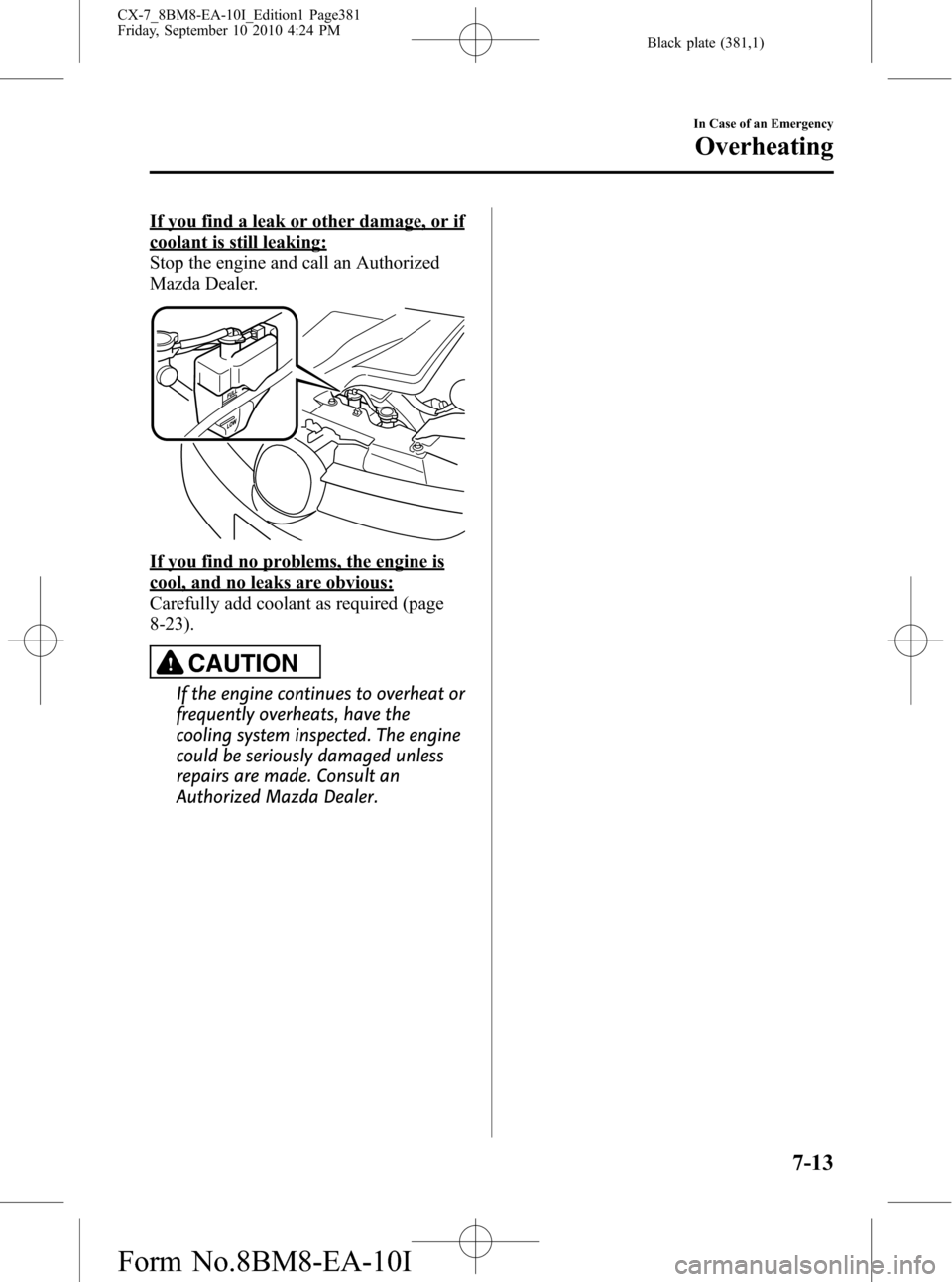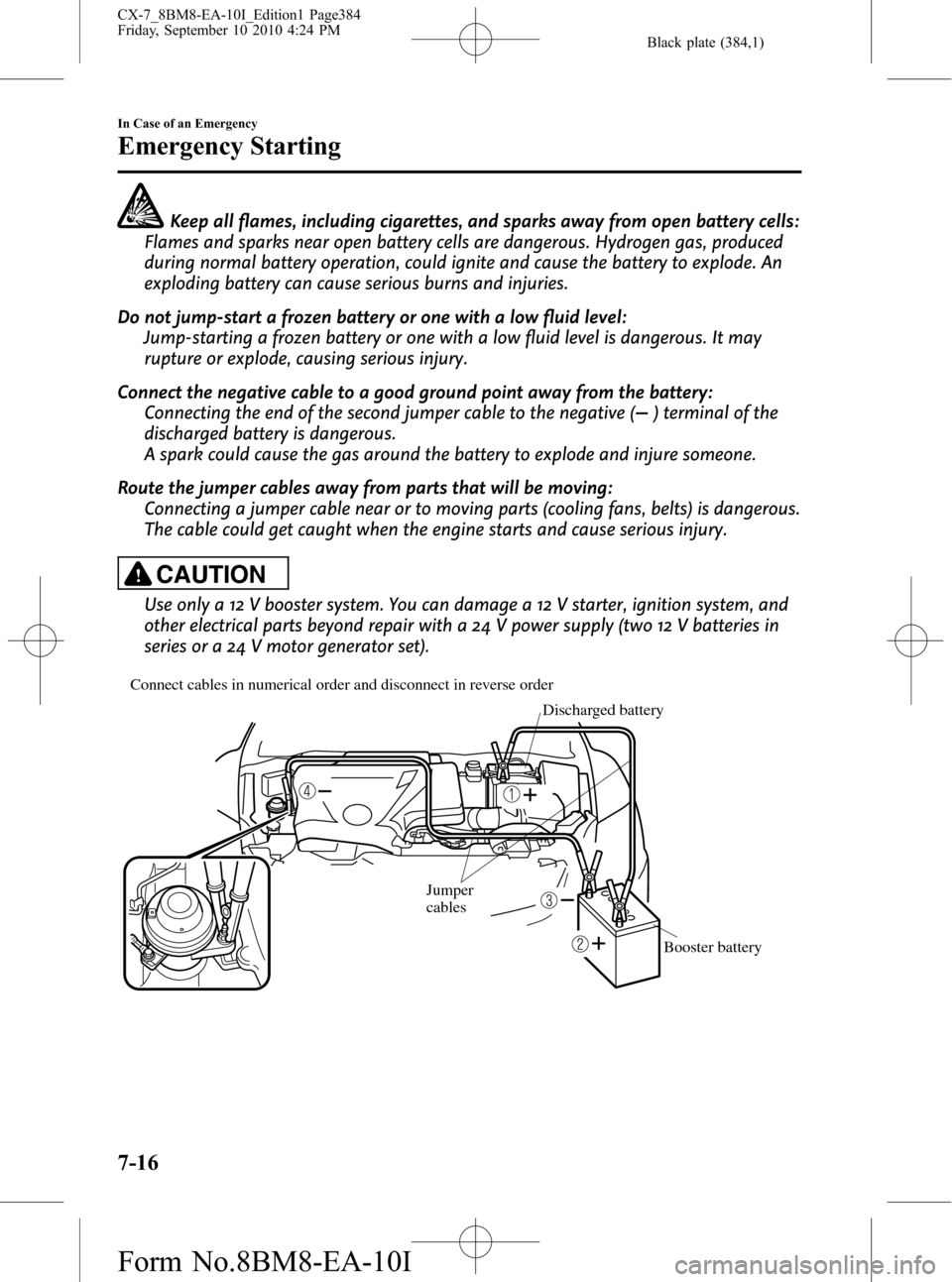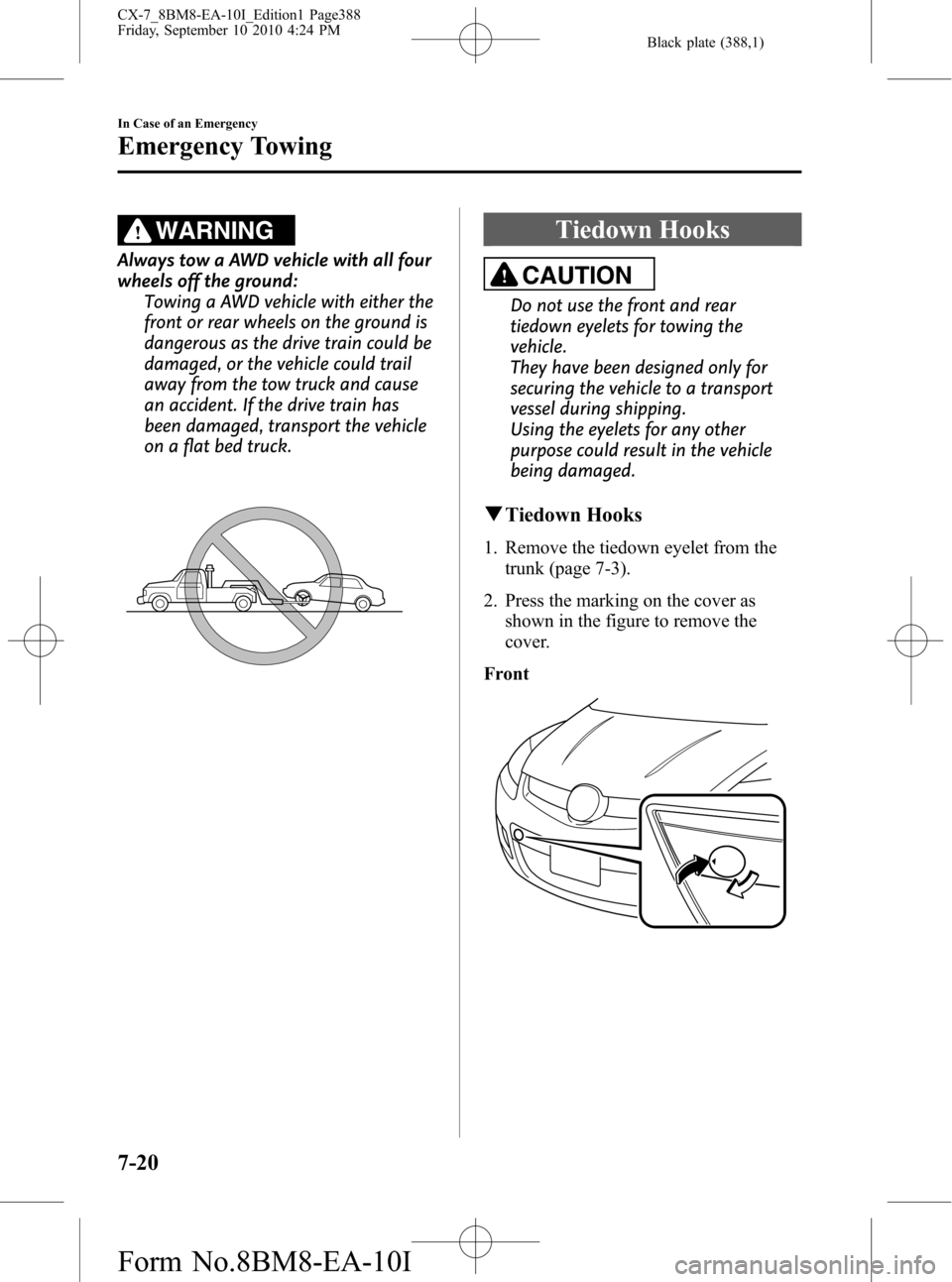MAZDA MODEL CX-7 2011 Owners Manual (in English)
Manufacturer: MAZDA, Model Year: 2011, Model line: MODEL CX-7, Model: MAZDA MODEL CX-7 2011Pages: 520, PDF Size: 8.75 MB
Page 381 of 520

Black plate (381,1)
If you find a leak or other damage, or if
coolant is still leaking:
Stop the engine and call an Authorized
Mazda Dealer.
If you find no problems, the engine is
cool, and no leaks are obvious:
Carefully add coolant as required (page
8-23).
CAUTION
If the engine continues to overheat or
frequently overheats, have the
cooling system inspected. The engine
could be seriously damaged unless
repairs are made. Consult an
Authorized Mazda Dealer.
In Case of an Emergency
Overheating
7-13
CX-7_8BM8-EA-10I_Edition1 Page381
Friday, September 10 2010 4:24 PM
Form No.8BM8-EA-10I
Page 382 of 520

Black plate (382,1)
Starting a Flooded Engine
If the engine fails to start, it may be
flooded (excessive fuel in the engine).
Follow this procedure:
1. If the engine does not start within five
seconds on the first try, switch the
ignition off, wait ten seconds and try
again.
2. Depress the accelerator all the way and
hold it there.
3. Switch the ignition to START and hold
it there―for up to ten seconds. If the
engine starts, release the key and
accelerator immediately because the
engine will suddenly rev up.
4. If the engine fails to start, crank it
without depressing the accelerator―for
up to ten seconds.
If the engine still does not start using the
above procedure, have your vehicle
inspected by an Authorized Mazda
Dealer.
7-14
In Case of an Emergency
Emergency Starting
CX-7_8BM8-EA-10I_Edition1 Page382
Friday, September 10 2010 4:24 PM
Form No.8BM8-EA-10I
Page 383 of 520

Black plate (383,1)
Jump-Starting
Jump-starting is dangerous if done incorrectly. So follow the procedure carefully. If you
feel unsure about jump-starting, we strongly recommend that you have a competent service
technician do the work.
WARNING
Follow These Precautions Carefully:
To ensure safe and correct handling of the battery, read the following precautions
carefully before using the battery or inspecting it.
Always wear eye protection when working near the battery:
Working without eye protection is dangerous. Battery fluid contains SULFURIC ACID
which could cause blindness if splashed into your eyes. Also, hydrogen gas produced
during normal battery operation, could ignite and cause the battery to explode.
Wear eye protection and protective gloves to prevent contact with battery
fluid:
Spilled battery fluid is dangerous.
Battery fluid contains SULFURIC ACID which could cause serious injuries if it gets in
eyes, skin or clothing. If this happens, immediately flush your eyes with water for 15
minutes or wash your skin thoroughly and get medical attention.
Always keep batteries out of the reach of children:
Allowing children to play near batteries is dangerous. Battery fluid could cause
serious injuries if it gets in the eyes or on the skin.
Do not allow the positive () terminal to contact any other metal object that
could cause sparks:
Flames and sparks near open battery cells are dangerous. Hydrogen gas, produced
during normal battery operation, could ignite and cause the battery to explode. An
exploding battery can cause serious burns and injuries. When working near a
battery, do not allow metal tools to contact the positive (
) or negative ()
terminal of the battery.
In Case of an Emergency
Emergency Starting
7-15
CX-7_8BM8-EA-10I_Edition1 Page383
Friday, September 10 2010 4:24 PM
Form No.8BM8-EA-10I
Page 384 of 520

Black plate (384,1)
Keep all flames, including cigarettes, and sparks away from open battery cells:
Flames and sparks near open battery cells are dangerous. Hydrogen gas, produced
during normal battery operation, could ignite and cause the battery to explode. An
exploding battery can cause serious burns and injuries.
Do not jump-start a frozen battery or one with a low fluid level:
Jump-starting a frozen battery or one with a low fluid level is dangerous. It may
rupture or explode, causing serious injury.
Connect the negative cable to a good ground point away from the battery:
Connecting the end of the second jumper cable to the negative (
) terminal of the
discharged battery is dangerous.
A spark could cause the gas around the battery to explode and injure someone.
Route the jumper cables away from parts that will be moving:
Connecting a jumper cable near or to moving parts (cooling fans, belts) is dangerous.
The cable could get caught when the engine starts and cause serious injury.
CAUTION
Use only a 12 V booster system. You can damage a 12 V starter, ignition system, and
other electrical parts beyond repair with a 24 V power supply (two 12 V batteries in
series or a 24 V motor generator set).
Connect cables in numerical order and disconnect in reverse order
Booster battery Jumper
cablesDischarged battery
7-16
In Case of an Emergency
Emergency Starting
CX-7_8BM8-EA-10I_Edition1 Page384
Friday, September 10 2010 4:24 PM
Form No.8BM8-EA-10I
Page 385 of 520

Black plate (385,1)
1. Remove the battery cover.
2. Make sure the booster battery is 12 V
and that its negative terminal is
grounded.
3. If the booster battery is in another
vehicle, don't allow both vehicles to
touch. Turn off the engine of the
vehicle with the booster battery and all
unnecessary electrical loads in both
vehicles.
4. Connect the jumper cables in the exact
sequence as in the illustration.
lConnect one end of a cable to the
positive terminal on the discharged
battery (1).
lAttach the other end to the positive
terminal on the booster battery (2).
lConnect one end of the other cable
to the negative terminal of the
booster battery (3).
lConnect the other end to the ground
point indicated in the illustration
away from the discharged battery
(4).
5. Start the engine of the booster vehicle
and run it a few minutes. Then start the
engine of the other vehicle.6. When finished, carefully disconnect the
cables in the reverse order described in
the illustration.
7. If the battery cover has been removed,
install it in the reverse order of
removal.
NOTE
Verify that the covers are securely installed.
In Case of an Emergency
Emergency Starting
7-17
CX-7_8BM8-EA-10I_Edition1 Page385
Friday, September 10 2010 4:24 PM
Form No.8BM8-EA-10I
Page 386 of 520

Black plate (386,1)
Push-Starting
Do not push-start your Mazda.
NOTE
You can't start a vehicle with an automatic
transaxle by pushing it.
7-18
In Case of an Emergency
Emergency Starting
CX-7_8BM8-EA-10I_Edition1 Page386
Friday, September 10 2010 4:24 PM
Form No.8BM8-EA-10I
Page 387 of 520

Black plate (387,1)
Towing Description
We recommend that towing be done only
by an Authorized Mazda Dealer or a
commercial tow-truck service.
Proper lifting and towing are necessary to
prevent damage to the vehicle.
Particularly when towing a AWD vehicle,
where all the wheels are connected to the
drive train, proper transporting of the
vehicle is absolutely essential to avoid
damaging the drive system. Government
and local laws must be followed.
Wheel dollies
A towed 2WD vehicle should have its
drive wheels (front wheels) off the
ground. If excessive damage or other
conditions prevent this, use wheel dollies.
When towing a 2WD vehicle with the rear
wheels on the ground, release the parking
brake.
A towed AWD vehicle must have all its
wheels off the ground.
CAUTION
Do not tow the vehicle pointed
backward with driving wheels on the
ground. This may cause internal
damage to the transaxle.
CAUTION
Do not tow with sling-type
equipment. This could damage your
vehicle. Use wheel-lift or flatbed
equipment.
In Case of an Emergency
Emergency Towing
7-19
CX-7_8BM8-EA-10I_Edition1 Page387
Friday, September 10 2010 4:24 PM
Form No.8BM8-EA-10I
Page 388 of 520

Black plate (388,1)
WARNING
Always tow a AWD vehicle with all four
wheels off the ground:
Towing a AWD vehicle with either the
front or rear wheels on the ground is
dangerous as the drive train could be
damaged, or the vehicle could trail
away from the tow truck and cause
an accident. If the drive train has
been damaged, transport the vehicle
on a flat bed truck.
Tiedown Hooks
CAUTION
Do not use the front and rear
tiedown eyelets for towing the
vehicle.
They have been designed only for
securing the vehicle to a transport
vessel during shipping.
Using the eyelets for any other
purpose could result in the vehicle
being damaged.
qTiedown Hooks
1. Remove the tiedown eyelet from the
trunk (page 7-3).
2. Press the marking on the cover as
shown in the figure to remove the
cover.
Front
7-20
In Case of an Emergency
Emergency Towing
CX-7_8BM8-EA-10I_Edition1 Page388
Friday, September 10 2010 4:24 PM
Form No.8BM8-EA-10I
Page 389 of 520

Black plate (389,1)
Rear
CAUTION
The cap cannot be completely
removed. Do not use excessive force
as it may damage the cap or scratch
the painted bumper surface.NOTE
If it is difficult to remove the tiedown eyelet,
wrap the jack lever with a cloth as shown in
the figure and press the marking on the cover
to remove it.
Front
Rear
3. Securely install the tiedown eyelet
using the lug wrench.
In Case of an Emergency
Emergency Towing
7-21
CX-7_8BM8-EA-10I_Edition1 Page389
Friday, September 10 2010 4:24 PM
Form No.8BM8-EA-10I
Page 390 of 520

Black plate (390,1)
Front
Lug wrench
Rear
Lug wrench
4. Hook the tying rope to the tiedown
eyelet.
Front
Rear
CAUTION
If the tiedown eyelet is not securely
tightened, it may loosen or disengage
from the bumper when tying down
the vehicle. Make sure that the
tiedown eyelet is securely tightened
to the bumper.
7-22
In Case of an Emergency
Emergency Towing
CX-7_8BM8-EA-10I_Edition1 Page390
Friday, September 10 2010 4:24 PM
Form No.8BM8-EA-10I